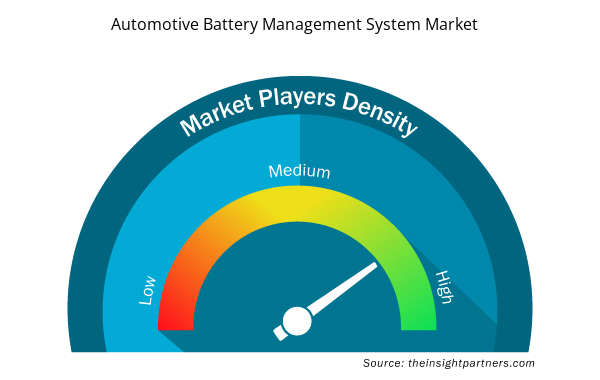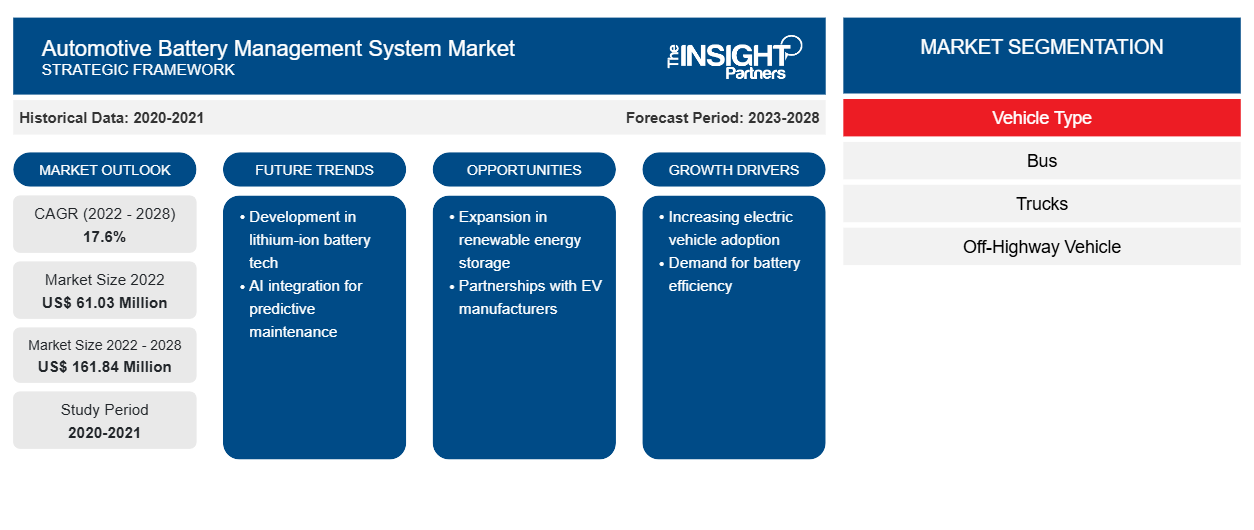汽车电池管理系统市场预计将从 2022 年的 6103 万美元增长;预计从 2022 年到 2028 年的复合年增长率为 17.6%。
电池管理系统可管理高压混合动力汽车和电动汽车中使用的电池。电动汽车制造商和电池组制造商将电池管理系统集成到锂离子电池中以保护电池组。电动汽车中的整体电池系统是电池模块、传感器、控制器、热管理系统和电池管理系统等多个组件的组合。随着人们对环境保护的关注度不断提高以及政府为减少排放而采取的积极举措,预计在 2022 年至 2028 年的预测期内,对电动和混合动力汽车的需求将以惊人的速度增长。这反过来将推动汽车电池管理系统市场的增长。
全球电动汽车和电池组行业的特点是,存在一些非常知名且财力雄厚的公司,例如三菱、日产和特斯拉。因此,汽车电池管理系统市场规模的买方议价能力相当高。由于电动汽车的持续研发以及汽车电池管理系统市场的快速增长,预计买方的议价能力在 2019-2027 年期间将保持较高水平。汽车电池管理系统市场规模的主要公司在为其车辆规划电池系统时采用不同的策略。技术领域的不断进步预计将给电池管理系统供应商带来压力,迫使他们适应变化以维持其市场地位。由于这一事实,买家也倾向于在一段时间内根据其特定要求和 BMS 供应商的技术组合更换 BMS 供应商。
定制此报告以满足您的需求
您可以免费定制任何报告,包括本报告的部分内容、国家级分析、Excel 数据包,以及为初创企业和大学提供优惠和折扣
- 获取此报告的关键市场趋势。这个免费样品将包括数据分析,从市场趋势到估计和预测。
COVID-19 疫情对汽车电池管理系统市场份额的影响
2020 年,COVID-19 疫情在全球经济高峰期爆发,严重影响了制造业的商业活动。疫情爆发之前,由于电动汽车销量增加、可支配收入激增以及信贷和融资的便利,汽车电池管理系统市场份额正在大幅增长。此外,电动汽车开发的重大投资举措推动了对汽车电池管理系统的需求。根据国际清洁交通委员会的数据,2021 年全球电动汽车销量达到创纪录的 690 万辆,比 2020 年增长了 107%。然而,COVID-19 疫情的爆发减缓了对电动汽车的投资和生产。在疫情爆发的最初几天,危机严重限制了所有扰乱汽车电池管理系统市场的商业交易、合作和伙伴关系。疫情的爆发阻碍了 2020 年 2 月的汽车销售;此外,到 4 月份,美国的汽车销量下降了 47%,欧洲的汽车销量下降了 80%。根据 Statista 的报告,2020 年全球汽车销量降至 6380 万辆,2021 年销量缓慢复苏,达到 6600 万辆。
市场洞察 – 汽车电池管理系统市场
电动汽车销量增长和电动汽车基础设施扩张
由于人们对环境保护的关注度不断提高,以及政府支持采用低排放和零排放汽车的政策,电动汽车 (EV) 的销量正在快速增长。政府提供的补贴和退税鼓励制造商扩大生产规模。根据《全球电动汽车展望》,包括全电动和插电式混合动力汽车在内的电动汽车销量在 2021 年达到 660 万辆。同年,中国销量飙升至 330 万辆,约占全球销量的一半。此外,2021 年欧洲的电动汽车销量增长了 65%,达到 230 万辆,而美国的销量翻了一番,达到 63 万辆。因此,对充电基础设施的投资增加和政府优惠政策数量的增加正在推动电池制造规模的扩大,从而刺激了汽车电池管理系统市场的需求。
基于车辆类型的洞察
根据车辆类型,汽车电池管理系统市场细分为公共汽车、卡车和非公路用车。2022 年,由于公共汽车越来越多地采用电池来减少碳排放,公共汽车部门占据了汽车电池管理系统市场的最大份额。此外,预计卡车部门在预测期内的复合年增长率最高。由于对最佳电池性能和电池组温度监控的追求日益增多,电动公共汽车制造商对电池管理系统的需求正在显着增加。此外,为了减少碳排放,不同国家对电动校车的需求也在增长,这也使电动校车制造商能够扩大生产线。不同国家的多个政府正在采用绿色技术公共汽车,这推动了对电动客车的需求,从而促进了汽车电池管理系统市场的增长。
汽车电池管理系统市场区域洞察
Insight Partners 的分析师已详尽解释了预测期内影响汽车电池管理系统市场的区域趋势和因素。本节还讨论了北美、欧洲、亚太地区、中东和非洲以及南美和中美洲的汽车电池管理系统市场细分和地理位置。

- 获取汽车电池管理系统市场的区域特定数据
汽车电池管理系统市场报告范围
| 报告属性 | 细节 |
|---|---|
| 2022 年市场规模 | 6103万美元 |
| 2028 年市场规模 | 1.6184亿美元 |
| 全球复合年增长率(2022 - 2028) | 17.6% |
| 史料 | 2020-2021 |
| 预测期 | 2023-2028 |
| 涵盖的领域 | 按车辆类型
|
| 覆盖地区和国家 | 北美
|
| 市场领导者和主要公司简介 |
|
汽车电池管理系统市场参与者密度:了解其对业务动态的影响
汽车电池管理系统市场正在快速增长,这得益于终端用户需求的不断增长,而这些需求又源于消费者偏好的不断变化、技术进步以及对产品优势的认识不断提高等因素。随着需求的增加,企业正在扩大其产品范围,进行创新以满足消费者的需求,并利用新兴趋势,从而进一步推动市场增长。
市场参与者密度是指在特定市场或行业内运营的企业或公司的分布情况。它表明在给定市场空间中,相对于其规模或总市场价值,有多少竞争对手(市场参与者)存在。
在汽车电池管理系统市场运营的主要公司有:
- 大陆汽车
- 达纳有限公司
- 捷恩
- 汉农系统
- 马勒有限公司
免责声明:上面列出的公司没有按照任何特定顺序排列。

- 了解汽车电池管理系统市场顶级关键参与者概况
汽车电池管理系统市场的参与者主要专注于开发先进、高效的产品。
- 2021 年 8 月,电池专家 Varta 与开发和生产服务提供商 Continental Engineering Services (CES) 宣布合作。作为首个试点项目的一部分,两家合作伙伴共同开发了一款用于功率为 10 千瓦及以上的电动两轮车的可更换 48 伏电池组。
- 2021 年 6 月,为电动汽车领域打造卓越热管理系统的以色列公司 Carrar 宣布,市场领导者和尖端热管理解决方案创造者 Gentherm 是种子轮融资的领投者。
汽车电池管理系统市场分为五大区域——北美、欧洲、亚太地区 (APAC)、世界其他地区。2022 年,亚太地区以可观的收入份额领先市场,其次是欧洲。此外,预计亚太地区将在 2022 年至 2028 年期间实现市场最高复合年增长率。
大陆集团、达纳有限公司、GENTHERM、Hanon Systems、Mahle GmbH、恩智浦半导体、瑞萨电子株式会社、罗伯特·博世有限公司、法雷奥和马瑞利控股有限公司是汽车电池管理系统市场的主要参与者。市场报告提供了详细的市场洞察,可帮助主要参与者制定未来几年的增长战略。
- 历史分析(2 年)、基准年、预测(7 年)及复合年增长率
- PEST 和 SWOT 分析
- 市场规模价值/数量 - 全球、区域、国家
- 行业和竞争格局
- Excel 数据集



Report Coverage
Revenue forecast, Company Analysis, Industry landscape, Growth factors, and Trends

Segment Covered
This text is related
to segments covered.

Regional Scope
North America, Europe, Asia Pacific, Middle East & Africa, South & Central America

Country Scope
This text is related
to country scope.
常见问题
Increasing Sales of EVs and Expansion of EV Infrastructure driving the need for Automotive Battery Management System market. Electric vehicle (EV) sales are growing at a fast pace owing to increasing concerns about environmental protection and government policies favoring the adoption of low-emission and zero-emission vehicles. Subsidies and tax rebates offered by governments encourage manufacturers to scale up their processes.
Wireless Automotive Battery Management System is propelling the market growth. A large amount of wiring goes into an EV to connect individual cells in a battery pack, and these wires are liable to safety failures. Wireless connectivity results in high reliability, reduced costs, and decreased weight in large multicell battery packs. Wireless connections are also allowing EV manufacturers to experiment with the placement of flexible battery modules and the installation of additional sensors in the place of wires. Wireless technologies such as Zigbee and point-to-point wireless topology are being used to enable wireless battery management systems.
Asia Pacific is the fastest growing regional market, followed by North America.
Mexico and India are expected to register high growth rates during the forecast period.
The key players, holding majority shares, in Automotive Battery Management System market includes Continental AG; Dana Limited; GENTHERM; Hanon Systems; and Mahle GmbH.
The US held the largest market share in 2022, followed by China.
The incremental growth, expected to be recorded for the Automotive Battery Management System market during the forecast period, is US$ 100.81 million.
The global Automotive Battery Management System market was estimated to be US$ 61.03 million in 2022 and is expected to grow at a CAGR of 17.6%, during the forecast period 2022 - 2028.
Trends and growth analysis reports related to Energy and Power : READ MORE..
The List of Companies - Automotive Battery Management System Market
- CONTINENTAL AG
- DANA LIMITED
- GENTHERM
- HANON SYSTEMS
- MAHLE GMBH
- NXP SEMICONDUCTORS
- RENESAS ELECTRONICS CORPORATION
- ROBERT BOSCH GMBH
- VALEO
- MARELLI HOLDINGS CO., LTD
The Insight Partners performs research in 4 major stages: Data Collection & Secondary Research, Primary Research, Data Analysis and Data Triangulation & Final Review.
- Data Collection and Secondary Research:
As a market research and consulting firm operating from a decade, we have published and advised several client across the globe. First step for any study will start with an assessment of currently available data and insights from existing reports. Further, historical and current market information is collected from Investor Presentations, Annual Reports, SEC Filings, etc., and other information related to company’s performance and market positioning are gathered from Paid Databases (Factiva, Hoovers, and Reuters) and various other publications available in public domain.
Several associations trade associates, technical forums, institutes, societies and organization are accessed to gain technical as well as market related insights through their publications such as research papers, blogs and press releases related to the studies are referred to get cues about the market. Further, white papers, journals, magazines, and other news articles published in last 3 years are scrutinized and analyzed to understand the current market trends.
- Primary Research:
The primarily interview analysis comprise of data obtained from industry participants interview and answers to survey questions gathered by in-house primary team.
For primary research, interviews are conducted with industry experts/CEOs/Marketing Managers/VPs/Subject Matter Experts from both demand and supply side to get a 360-degree view of the market. The primary team conducts several interviews based on the complexity of the markets to understand the various market trends and dynamics which makes research more credible and precise.
A typical research interview fulfils the following functions:
- Provides first-hand information on the market size, market trends, growth trends, competitive landscape, and outlook
- Validates and strengthens in-house secondary research findings
- Develops the analysis team’s expertise and market understanding
Primary research involves email interactions and telephone interviews for each market, category, segment, and sub-segment across geographies. The participants who typically take part in such a process include, but are not limited to:
- Industry participants: VPs, business development managers, market intelligence managers and national sales managers
- Outside experts: Valuation experts, research analysts and key opinion leaders specializing in the electronics and semiconductor industry.
Below is the breakup of our primary respondents by company, designation, and region:

Once we receive the confirmation from primary research sources or primary respondents, we finalize the base year market estimation and forecast the data as per the macroeconomic and microeconomic factors assessed during data collection.
- Data Analysis:
Once data is validated through both secondary as well as primary respondents, we finalize the market estimations by hypothesis formulation and factor analysis at regional and country level.
- Macro-Economic Factor Analysis:
We analyse macroeconomic indicators such the gross domestic product (GDP), increase in the demand for goods and services across industries, technological advancement, regional economic growth, governmental policies, the influence of COVID-19, PEST analysis, and other aspects. This analysis aids in setting benchmarks for various nations/regions and approximating market splits. Additionally, the general trend of the aforementioned components aid in determining the market's development possibilities.
- Country Level Data:
Various factors that are especially aligned to the country are taken into account to determine the market size for a certain area and country, including the presence of vendors, such as headquarters and offices, the country's GDP, demand patterns, and industry growth. To comprehend the market dynamics for the nation, a number of growth variables, inhibitors, application areas, and current market trends are researched. The aforementioned elements aid in determining the country's overall market's growth potential.
- Company Profile:
The “Table of Contents” is formulated by listing and analyzing more than 25 - 30 companies operating in the market ecosystem across geographies. However, we profile only 10 companies as a standard practice in our syndicate reports. These 10 companies comprise leading, emerging, and regional players. Nonetheless, our analysis is not restricted to the 10 listed companies, we also analyze other companies present in the market to develop a holistic view and understand the prevailing trends. The “Company Profiles” section in the report covers key facts, business description, products & services, financial information, SWOT analysis, and key developments. The financial information presented is extracted from the annual reports and official documents of the publicly listed companies. Upon collecting the information for the sections of respective companies, we verify them via various primary sources and then compile the data in respective company profiles. The company level information helps us in deriving the base number as well as in forecasting the market size.
- Developing Base Number:
Aggregation of sales statistics (2020-2022) and macro-economic factor, and other secondary and primary research insights are utilized to arrive at base number and related market shares for 2022. The data gaps are identified in this step and relevant market data is analyzed, collected from paid primary interviews or databases. On finalizing the base year market size, forecasts are developed on the basis of macro-economic, industry and market growth factors and company level analysis.
- Data Triangulation and Final Review:
The market findings and base year market size calculations are validated from supply as well as demand side. Demand side validations are based on macro-economic factor analysis and benchmarks for respective regions and countries. In case of supply side validations, revenues of major companies are estimated (in case not available) based on industry benchmark, approximate number of employees, product portfolio, and primary interviews revenues are gathered. Further revenue from target product/service segment is assessed to avoid overshooting of market statistics. In case of heavy deviations between supply and demand side values, all thes steps are repeated to achieve synchronization.
We follow an iterative model, wherein we share our research findings with Subject Matter Experts (SME’s) and Key Opinion Leaders (KOLs) until consensus view of the market is not formulated – this model negates any drastic deviation in the opinions of experts. Only validated and universally acceptable research findings are quoted in our reports.
We have important check points that we use to validate our research findings – which we call – data triangulation, where we validate the information, we generate from secondary sources with primary interviews and then we re-validate with our internal data bases and Subject matter experts. This comprehensive model enables us to deliver high quality, reliable data in shortest possible time.


 获取此报告的免费样本
获取此报告的免费样本